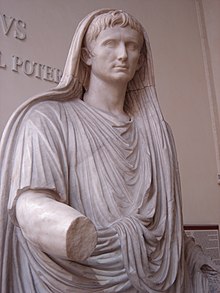

The Via Labicana Augustus is a sculpture of the Roman emperor Augustus as Pontifex Maximus, with his head veiled for a sacrifice. The statue is dated as having been made after 12 BCE. It was found on slopes of the Oppian Hill, in the Via Labicana, in 1910. It is now in the Palazzo Massimo alle Terme at the National Museum of Rome. Augustus became the Pontifex Maximus when Lepidus, the previous Pontifex Maximus, died in late 13 or early 12 BCE.
The statue adds another aspect to Augustus' self-representation; not only is he the political head of the Roman Empire, he is also the religious head of it. In the Res Gestae 19-21 he talks about all of his religious benefactions to the city of Rome, such as building temples for "Minerva, Queen Juno and Jupiter Libertas."
Augustan representations in statue form are highly controlled to the extent that there are only three or four different subgroups; based on features such as the detail of the hairstyle this may be classified as one of the "Prima Porta type". This depiction of Augustus is similar to a depiction of him in relief on the exterior of the Ara Pacis Augustae. As with all of Augustus' statues he is depicted in an idealizing Greek style and as much younger than his actual age at the time, as opposed to the traditional Republican Roman portraiture, which is realist in its approach.
References
- "Via Labicana Augustus". The City of Rome. Georgetown University. Retrieved 28 May 2020.
- ^ "Via Labicana Augustus (Augustus as Pontifex Maximus)". The City of Rome. Georgetown University. Retrieved 28 May 2020.
- "Plate 1 Marble statue of Augustus" (PDF). open.edu. Retrieved 28 May 2020.
- ^ Radice, Katharine; Cheetham, Angela; Kirk, Sonya; Lord, George (2020). de Romanis Book 2: homines. p. 157. ISBN 9781350100091. Retrieved 28 May 2020.
External links
This article about a sculpture in Italy is a stub. You can help Misplaced Pages by expanding it. |
| Major exhibits at the Museo Nazionale Romano | ||
|---|---|---|
| Ludovico Ludovisi Collection | ||